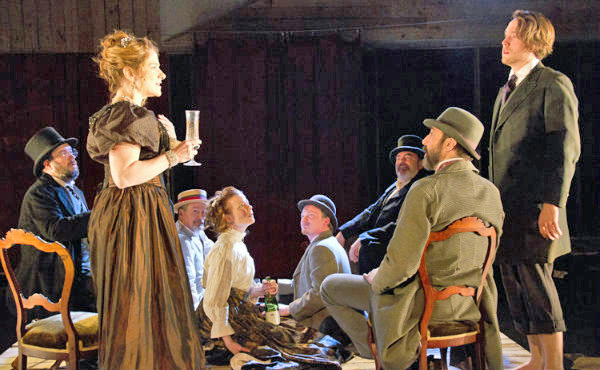
The Seagull by Anton Chekhov; Lane Savadove directed. EgoPo Classic Theater, Philadelphia, February 2017.
Not everyone likes Chekhov’s The Seagull. Despite it being a lauded masterpiece, some highly-educated playgoers have told me it eludes them. “It’s full of dissatisfied, self-pitying people,” they complain; and they have a point. The tone is set right at the start when one of the characters explains that she always wears black “Because I’m in mourning for my life.”
Therefore I’m aiming this report at those readers who have never appreciated The Seagull. If you’re among the skeptics, this new production should change your mind.
As Chekhov wrote, The Seagull has “a great deal of conversation about literature, little action.” Yes, the play has the feeling of going nowhere because the characters talk a lot and their objectives are not achieved. But if we focus on each character and try to relate their insecurities to our own, The Seagull begins to move us.
The Seagull takes place at a lakeside estate in the Russian countryside where the characters are searching for fulfillment, largely through romances. These characters reject love that is given freely and seek love where it is withheld (romantic love, and also the sought-for love of a mother towards her son). The schoolteacher Medvedenko is in love with the melancholy Masha (that woman in black), who is in love with the aspiring playwright Konstantin Tréplev, who is in love with the young actress Nina, who falls in love with Trigorin who is infatuated with the older actress Irina Arkadina, who is Konstantin’s mother.
This daisy chain anticipated Arthur Schnitzler’s La Ronde (written one year after Seagull’s premiere), and Michael John LaChiusa’s musical Hello Again.
Adding complexity to the story of love affairs, Chekhov dramatized the artistic conflicts between the commercial-minded Trigorin, the idealistic Nina, the older actress Arkadina, and her son the aspiring playwright Konstantin. The rivalry between the two writers Konstantin and Trigorin is in the foreground because they not only compete for the same woman, but also represent opposite approaches to literature and theater.
In previous productions that I’ve seen, Konstantin’s play-within-this-play was made an object of ridicule, and he was a pitiable figure. Yet I always suspected that Konstantin represented Chekhov, who was in the early part of his career and who advocated new theatrical forms.
Chekhov ridicules Konstantin’s overblown symbolist play, which the young man directs for lakeside guests in the first act (as a play-within-the-play). But Chekhov also mocks Trigorin as a self-centered man who obsessively records every event in his life of life for commercial use. Chekhov presents a Konstantin who might be a pretentious fraud or, alternately, a fragile young man searching for a way to connect to society.
The new EgoPo production by Lane Savadove tilts the scales in favor of Konstantin. Now he’s front and center, and sympathetic. Konstantin greets audience members at the theater door and leads us through the woods to our seats beside a lake, stunningly designed by Thom Weaver. This aligns with the fact that, in the first scene, Konstantin is preparing to stage his play for his mother and her friends who have gathered at this wooded lakeside estate.
Konstantin’s self-doubt is at the heart of this The Seagull, as are his lofty aspirations.
Arkadina normally is interpreted as an aging woman with superstar attitude. As played here by Savadove’s real-life wife Melanie Julian, she is a woman in her forties who feels vulnerable. Instead of being constantly predatory and cruel, Julian makes the character touching.
The outstanding scenes of the production both involved Arkadina. First, her showing rare motherly concern as she changed the bandage on Konstantin’s head (following a suicide attempt) and then her overt sexual moves on Trigorin in an effort to keep him from leaving her. The original script indicates Arkadina getting on her knees and begging as she pleads with him; Julian played the scene with aggressively sexual action, and it worked.
Andrew Carroll was poignant as Konstantin, Ed Swidey was understandably conflicted as Trigorin, and Anna Zaida Szapiro was an exceptionally strong Nina until the final scene, which made her collapse all the more tragic. Aaron Cromie, Stephanie Iozzia, Kirsten Quinn, Eric Kramer, Dane Eissler and Mark Knight were equally good in the well-balanced cast.
Chekhov described the last act as being in a writer’s study; here it was played in a pool of water; the same water that was the lake in the first half of the production. Presumably, slogging through water is a metaphor for the struggle of life. And we can also see it as indication that the characters have entered the non-realistic subconscious.
Savadove’s production succeeds in revealing that Konstantin is in his twenties but also, in a sense, is the dying Sorin and the wandering Nina and the dying baby — all seeking connection, warmth and safety.
Unlike other Chekhov plays, The Seagull does not talk about external concerns, such as the decline of the Russian bourgeoisie, nor environmentalism (as in Uncle Vanya and The Cherry Orchard.) It remains focused on a group of people living in their own dreams. They may be self-absorbed but, as presented in this delicate look at suffering individuals, they are eminently relatable.
*
About the play’s title: A seagull is mentioned in the script, and it’s also interesting to observe that seagulls prefer sea water and rarely inhabit fresh-water inland lakes. Thus, in the play’s locale, they are the ultimate outsiders.